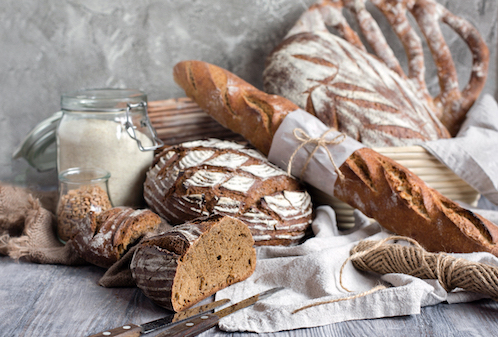
What is sourdough?
Sourdough is the original and oldest way of making bread and it is what we call real bread. It is far superior, in both taste and nutritional quality, to any kind of industrial bread.
In the early 20th century, technological advances allowed bread to be mass produced in factories. This industrialisation has resulted in ‘modern’ bread making, which includes the use of chemicals and additives to make production cheaper and give the bread a longer shelf life. These mass produced products have given bread a bad name and have caused many people to drop bread from their diet as they are associated with unpleasant symptoms, including bloating and constipation.
Sourdough bread is made with only three ingredients (water, flour, salt) as well as naturally occurring beneficial wild yeast and lactic acid bacteria (Lactobacillus spp.), together known as the starter. A key feature of sourdough baking is that it ferments slowly over several hours. This slow fermentation process not only helps to produce the flavour, but it also makes it more digestible and nutritious. The NHS even calls sourdough “Tummy friendly bread”.
What are the benefits of sourdough for your health?
- It is gut-friendly
Sourdough bread is less likely to cause gas production in the gut, a typical symptom of irritable bowel syndrome (IBS), when compared to industrial bread. A study has shown that gas production was significantly lower in IBS patients who consumed sourdough bread when compared to those who consumed conventional industrial bread, even if the industrial bread had been fermented for longer. Real sourdough will always be easier on digestion than mass produced bread.
- No worries about gluten
The lactic acid bacteria and the long fermentation process in sourdough modifies the structure of gluten proteins, gliadin and glutenin, present in wheat flour, making it more digestible. It has been shown to be better tolerated by people with non-coeliac gluten sensitivity, and even with coeliac disease, than industrial bread.
- It is more digestible and nutritious
The long fermentation process in sourdough neutralises the phytic acid in flour which otherwise would interfere with the absorption of nutrients. This means that important minerals and vitamins, such as calcium, zinc, magnesium, iron and B vitamins, are more readily available for absorption, and in higher amounts if unrefined flour is used. This is not the case with industrial bread which relies on a quick fermentation process.
- Can be used in a low FODMAPs diet
The traditional method of baking sourdough reduces the production of FODMAPs. These are types of carbohydrates (Fermentable Oligosaccharides, Disaccharides, Monosaccharides, and Polyols) that are associated with symptoms of IBS and gastrointestinal discomfort. The drawback of low FODMAP diets is that they often restrict the intake of dietary fibre, however using sourdough to make whole grain bread can help to reduce the FODMAPs in bread without losing the beneficial dietary fibre content.
- Supports healthy blood sugar levels and body weight
Sourdough bread has a low glycaemic index (GI), particularly whole-grain versions, when compared to industrial white bread, thanks to the action of lactic acid bacteria. This means that glucose is slowly released in the bloodstream, which helps to balance blood sugar and insulin levels, keeping inflammation and weight gain at bay. So, if you are also worried about weight gain, sourdough may be the bread for you.
- Keeps the immune system in check
There is some evidence that sourdough may help with auto-immune conditions due to different molecules that are synthesised during fermentation such as antioxidants, anti-allergenic elements, and the cancer preventive substance lunasin.
All the benefits of sourdough mentioned above can help support women during menopause. The hormone changes happening during the menopausal transition often affect digestion and can increase food intolerances. In addition, keeping your blood sugar and insulin levels balanced is a key factor in menopause, as it helps to maintain your hormone balance and a healthy weight.
How to choose the correct sourdough
When it comes to sourcing your sourdough bread, it is important to make sure you are getting the real deal. This is the only way you can assure you will be getting the benefits of sourdough and, very importantly, avoiding the side-effects associated with the additives present in industrial bread.
Genuine sourdough should be:
- Free of any artificial additives, including preservatives (the lactic acid present only in sourdough acts as a natural preservative)
- Leavened using a live sourdough culture (i.e. free of industrial/Baker’s/pre-mix yeast or other leavening agents such as baking powder)
- Free of additional ingredients (i.e. souring agents such as vinegar, yoghurt or dried sourdough powder)
- Produced through a long fermentation process of 18 – 24 hours.
Check the taste, texture and aroma:
A genuine sourdough should have an open crumb structure (i.e. big holes) with a moist and glossy texture in the inside, and a crackling crust on the outside. The taste and aroma should be complex and delicious. As for sourness, it can vary from a light to a more robust tang, depending on the starter used and skills of the baker.
If buying from a bakery (which is advisable), ask your baker how your sourdough was made (i.e. starter used, length of fermentation) and the list of ingredients. If buying from the supermarket shelves (or any packaged form of sourdough), it is quite likely you are not getting a genuine sourdough and you should always read the ingredients list to double-check.
Currently in the UK there is no legal definition of sourdough, and it is still possible to market bread as sourdough even if it contains some of the additives listed above (the Real Bread Campaign calls it “sourfaux”). This is the reason why the Real Bread Campaign is urging the government for an Honest Crust Act to include legal protection of the term sourdough, allowing us all to make better-informed choices about the food we eat. Visit the Real Bread Campaign’s website to find out more about their mission in sharing the word on how to make bread better for us.
How can I get good sourdough?
Baking your own sourdough at home is the best way to know what goes in. It is an art which takes dedication and practice but also comes with great reward and pleasure. And there is nothing better than filling your home with the smell of a freshly baked loaf!
If you would like to start baking sourdough and do not know where to start, please get in touch and I will be very happy to share some ins and outs.
Where does Vera get her sourdough from?
St John Bakery, E5 Bakehouse, Bread Ahead, Gail’s, Pavilion Bakery (in London).



